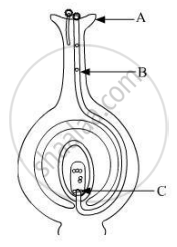Advertisements
Advertisements
प्रश्न
Pollen tube reaches the embryo sac via style.
पर्याय
True
False
उत्तर
True
APPEARS IN
संबंधित प्रश्न
Name the parts A, B and C shown in the diagram and write their functions.

Answer the following question.
What is pollination? Explain the different types of pollination.
How does fertilisation occur in flowers? Name the parts of the flower that develop into (i) seed, and (ii) fruit after fertilisation.
A student while observing an embryo of a pea seed in the laboratory listed various parts of the embryo as given below:
Testa, Tegmen, Radicle, Plumule, Micropyle, Cotyledon.
On examining the list the teacher remarked that only three parts are correct. Select three correct parts from the above list:
(a) Testa, Radicle, Cotyleddon
(b) Tegmen, Radicle, Micropyle
(c) Cotyledon, Plumule, Testa
(d) Radicle, Cotyledon, Plumule
Give one example of a unisexual flower.
Mention the changes a flower undergoes after fertilisation.
State the function of flowers in the flowering plants.
Sketch the reproductive parts of a flower.
Name the male part of the flower.
Where are a plant's sex organs located?
What are the reproductive organs in a flower?
Fill in the following blank with suitable word :
The female organ of reproduction in the flower is the...........
What is made in ovary of a flower?
Explain the terms 'self pollination'
Explain the terms 'cross-pollination'?
Name the part of a seed which grows into root.
Which of the following is the correct sequence of events of sexual reproduction in a flower?
(a) pollination, fertilisation, seed, embryo
(b) seed, embryo, fertilisation, pollination
(c) pollination, fertilisation, embryo, seed
(d) embryo, seed, pollination, fertilisation
In the figure given alongside, the parts marked A, B and C are sequentially :
(a) cotyledon, plumule and radicle
(b) plumule, radicle and cotyledon
(c) plumule, cotyledon and radicle
(d) radicle, cotyledon and plumule
The flask-shaped organ A at the centre of a flower is surrounded by a number of little stalks B having swollen tops which lie just inside the ring of petals.
(a) Name A. What are the various parts of A?
(b) Which part of A contains gametes?
(c) Name B. What is the swollen top of B known as?
(d) What does the swollen top of b contain?
(e) Out of A and B, which one is (i) male part, and (ii) female part of the flower?
Fill in the blank by selecting suitable word:
A flower that bears both the male and the female parts is known as __________ flower.
Fill in the blank by selecting suitable word:
A flower bearing only male or female parts is known as __________ flower.
Find the odd-one out, giving reason:
Anther, pollen grain, ovule male gamete
Mention the function of Flower.
Mention the function of Stigma.
What part is played by stamens and carpels in reproduction?
Write one main difference between asexual and sexual mode of reproduction. Which species is likely to have comparatively better chances of survival – the one reproducing asexually or the one reproducing sexually? Give reason to justify your answer.
“Cell division is a type of reproduction in unicellular organism.” Justify.
Write the names of male and female reproductive parts of a flower.
Prepare a slogan for campaign against female foeticide.
Fill in the blank by selecting suitable word:
Transfer of pollen grains from the anther to the stigma is known as______________.
Define.
Inflorescence
Observe the figure below. Write functions of the labelled parts.

The essential parts of a flower are ______.
Identify the parts A, B, C, and D?

In which part of the flower germination of pollen grains takes place?
Which of the following are the chemical components of the wall of pollen tube?
How many middle layers are generally present in the wall of the anther lobes?
Where is the zygote located in the flower after fertilization?
